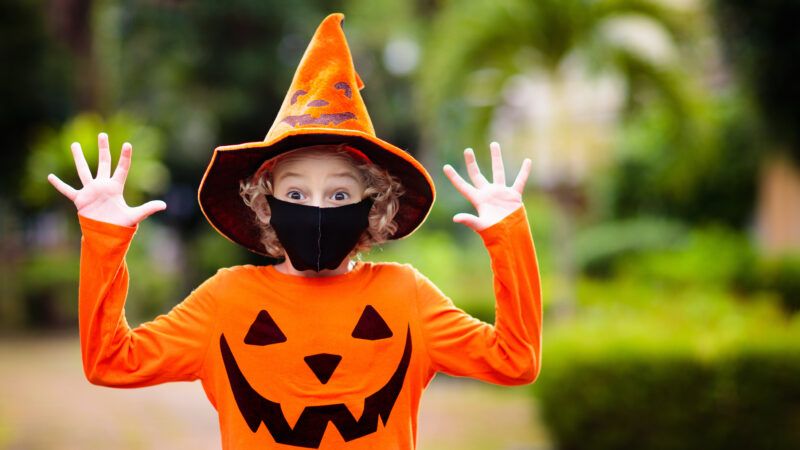Federal Government Still Tells Kids To Wear Masks on Halloween, For COVID-19 Safety
"Keep safe from COVID by following CDC advice to wear a mask."

Every year, government bureaucrats and doomsayers in the media issue deathly serious advice for avoiding Halloween dangers that are trivial, or even nonexistent. And 2022 is no exception.
The Consumer Product Safety Commission (CPSC) just issued a press release and infographic warning families about the potential gruesomeness of pumpkin-carving and kiddie costumes. It also suggested that mask-wearing might be appropriate—not as part of a costume, but as part of pandemic safety.
"Keep safe from COVID by following CDC advice to wear a mask," notes the infographic.
But do the Centers for Disease Control and Prevention (CDC) actually advise children to wear masks while trick-or-treating? It's almost impossible to tell from the website. The Halloween mask recommendations are from 2021, while a separate article, published in September, is headlined, "CDC no longer recommends universal masking in health facilities."
If people don't need to wear masks in health facilities, then kids probably don't need to wear them outdoors on Halloween. Perhaps the CPSC should update its information.
The guidance also tells parents that if they are making their child's costume, they should "begin crafting with safety in mind." Use polyester or nylon, the agency urges, because cotton and rayon burn rapidly. (Should kids avoid cotton the other 364 days of the year? Is cotton up there with mercury and lead as something kids must never be exposed to at all costs?)
The CPSC also says to avoid oversized costumes, because kids might trip and fall. How big a problem is this? The commission has no idea. It estimates that there were 3,200 Halloween related injuries last year, but the majority were incurred by adults. Just 25 percent involved tripping, which leaves about 400 injuries, or 1 for every 100,000 kids under the age of 10. That includes tripping over decorations, and tripping while just plain walking.
The CPSC goes on to tell parents to never let their kids carve a pumpkin; the kids can scoop out the innards if they absolutely insist on having fun.
Despite all those warnings, the infographic fails to mention the main danger: cars. Traffic-related injuries are by far the biggest threat to kids on Halloween. You might think look both ways before crossing the street would have earned a mention—ahead of don't trip on your Batman cape.
Meanwhile, there are yearly warnings from the media about avoiding people on the sex offender registry.
This year, Jacksonville, Florida, is particularly focused on the issue. Ever since 2010, Jacksonville has required registrants to put a sign on their lawn that says "no candy here." Those on probation risked six months in prison if they didn't comply, says Ray Taseff, an attorney at the Florida Justice Institute working to get the lawn sign law repealed.
While that has yet to happen, Jacksonville cops will not enforce the law because a very similar one was declared unconstitutional in the Court of Appeals for the Eleventh Circuit, which covers Georgia, Alabama, and Florida. Compelling citizens to post those signs amounts to compelling speech, the court ruled, and that violates the First Amendment.
Maybe the sign would make sense if trick or treaters were routinely being molested. But a Johns Hopkins study found that "the idea that sex offenders are more likely to harm children on Halloween is simply unfounded. The data don't prove it."
And speaking of needless scares, don't forget the Drug Enforcement Agency (DEA) cautioning parents that drug dealers could be giving kids "rainbow fentanyl" this year, even though there's little chance that trick-or-treaters are a reliable customer base. Happy Halloween!



Show Comments (72)